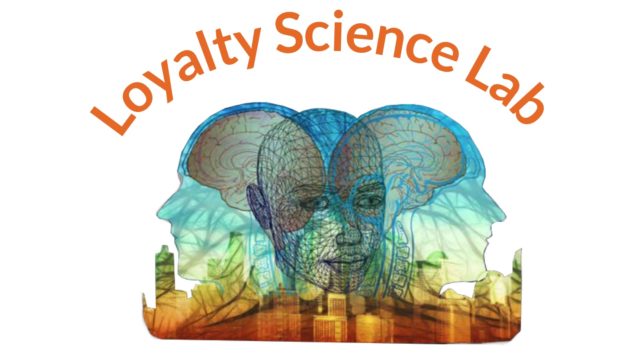In the last couple of months, I have been super busy starting a new exciting research initiative, the Loyalty Science Lab. Housed at my university, the Lab’s mission is to create and promote cutting-edge scientific research on brand and customer loyalty. Through collaborative efforts between marketing practitioners and academic researchers from multiple disciplines and multiple industries, the Loyalty Science Lab identifies high-priority loyalty-related issues, engages in deep, evidence-based scientific research on these issues, and disseminates the insight to benefit loyalty research and practice. I am happy to say that the Loyalty Science Lab is now up and running!
As its first major initiative, the Loyalty Science Lab spoke with a group of leading marketing practitioners and academics. The purpose of the conversations was to identify important loyalty-related issues that need deep, focused research. The questions generated through this process were further narrowed down by the experts on our advisory board into a list of top-tier and second-tier questions.
In this article, I would like to share with you the major loyalty issues we’ve identified that need more research at this time. For a complete list of the research questions, you can download The Loyalty Puzzle 2020–2022 edition.
Top-Tier Loyalty Research Areas
Area 1: Dealing with and recovering from large-scale disruptions
The COVID-19 pandemic has caused widespread disruptions across businesses and industries. More unexpected large-scale disruptions are likely to happen in the future. What can businesses do to best prepare for and handle such large-scale disruptions to ensure continuity in customer experience and loyalty? How do these interruptions change the consumer psyche and the meaning of loyalty? How will loyalty affect the post-disruption market landscape?
Area 2: Changing nature of loyalty and loyalty evolution
With the changing beliefs and values across generations of consumers and across time for the same consumers, what does loyalty mean today? Where are brands and consumers on the loyalty curve? How can businesses move their customers across the loyalty curve from apathetic to enthusiastic and from simple repeat purchase to love? What is the role of social in customer loyalty?
Area 3: Loyalty metrics and ROI issues
Businesses need valid and reliable measures of loyalty both to benchmark themselves and to quantify the impact of loyalty marketing strategies. What are the right metrics for loyalty today? Can we effectively measure loyalty through social conversations? How can the social values of consumers (e.g., as content creators, influencers, etc.) be captured in a holistic customer lifetime value measure? How to demonstrate the ROI on loyalty investments?
Area 4: Customer Experience
Few will dispute the importance of customer experience in driving loyalty. But what constitutes an “elevated” experience for consumers? Is it the reduction of friction, pleasant surprises, or something else? How can businesses meet the rising expectations about customer experience and delight their customers while remaining profitable?
Second-Tier Research Areas
Area 1: The role of social influence on loyalty
By now, most businesses have embraced social media into their marketing strategy. How are social media impacting loyalty? What types of social connections are most relevant to building and transferring loyalty? In the social media space, what is the best balance between overt brand messaging vs. subtle nudging? How to identify positive and negative trends through social conversations? How should brands talk to other brands in social media?
Area 2: Data, analytics, and privacy issues
There are lots of discussions about consumer privacy and ethical use of customer data. But consumers’ privacy concerns are more nuanced than general anxiety and fear. When and why do consumers trust enough to share their data? What are the best ways to manage data, data usage and data rights? How can data be effectively and ethically used to enhance customer experience and loyalty? How can businesses combine data and behavioral economics principles to nudge consumers?
Area 3: Enhancing customer experience and loyalty with technology
Companies now have a lot of technology-enabled touch points with consumers. When does technology benefit or do harm to customer experience? What is the right amount and right approach for technology-assisted customer interactions? How do AI and voice-assistive devices such as Amazon Echo and Google Home affect consumers’ information search and decision-making processes?
Area 4: Loyalty program design and management
An average consumer belongs to a dozen or more loyalty programs. Have consumers developed point fatigue for traditional points-based loyalty programs? How can social and engagement be built into a loyalty program? What should loyalty programs of the future look like? What is the value of having a formalized loyalty program? How to measure the ROI of such a program? How to communicate more effectively with members of a loyalty program?
Area 5: Loyalty in non-profit organizations
Non-profit organizations need loyal donors and supporters as much as businesses need loyal customers. But loyalty in the non-profit space is surprisingly low, and many non-profit organizations are spending most of their energy on going after new donors. Given limited resources, what is the proper balance between maintaining existing loyal donors and going after new ones? How do lifecycle stages affect consumers’ pattern of support for non-profit organizations and causes? How to turn individuals sympathetic toward a cause into actively supporting the organization?
Now that we’ve got the important questions down, it is time to get to work! In the coming months, the Lab will be engaging in various research projects and will share research insights to answer these questions. Please follow the Loyalty Science Lab on LinkedIn if you’d like to receive updates. In the meantime, I welcome your thoughts and ideas about these research questions. If you are interested in working together to solve some of these puzzles, I’d love to chat with you too.
